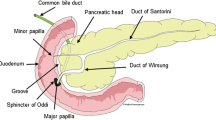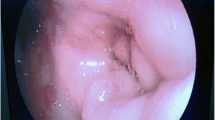Abstract
Groove pancreatitis is a distinct form of chronic pancreatitis characterized by inflammation and fibrous tissue formation, affecting the groove area between the head of the pancreas, the duodenum and the common bile duct. It is manifested on imaging by a sheet-like mass in the groove area near the minor papilla. Thickening of the duodenal wall and cystic transformation in the duodenal wall also represent common imaging features. Pathogenesis is still unclear, and clinical presentation is not specific. Endoscopic ultrasonography (EUS), computed tomography (CT) and magnetic resonance imaging (MRI) demonstrate imaging findings consistent with the disease in typical cases, but specific diagnosis is challenging in a number of patients where biopsy is required. The disease may mimic pancreatic, common bile duct or duodenal wall cancer that requires prompt and excessive surgical intervention, as opposed to groove pancreatitis where initial conservative treatment is suggested. The clinical, histopathological and radiological features on cross-sectional imaging of this entity are discussed in this review, and differential diagnostic clues are given.










Similar content being viewed by others
References
Becker V (1973) Bauchpeicheldtuse. In: Doerr W, Seifert G, Uhlinger E (eds) Spezielle pathologische Anatomie, Bd. VI. Springer, Berlin/ Heidelberg/New York, pp 252–445
Stolte M, Weiss W, Rosch W (1982) A special form of segmental pancreatitis: “groove pancreatitis”. Hepatogastroenterology 29:198–208
Becker V, Mischke U (1991) Groove pancreatitis. Int J Pancreatol 10:173–182
Yamaguchi K, Tanaka M (1992) Groove pancreatitis masquerading as pancreatic carcinoma. Am J Surg 163:312–316
Balakrishnan V, Chatni S, Radhakrishnan L et al (2007) Groove pancreatitis: a case report and review of the literature. JOP 8(5):592–597
Shudo R, Obara T, Tanno S et al (1998) Segmental groove pancreatitis accompanied by protein plugs in Santorini’s duct. J Gastroenterol 33:289–294
Silverman PM, McVay L, Zeman RK et al (1989) Pancreatic pseudotumor in pancreas divisum: CT characteristics. J Comput Assist Tomogr 13:140–141
Warshaw AL, Richter JM, Schapiro RH (1983) The cause and treatment of pancreatitis associated with pancreas divisum. Ann Surg 198:443–452
Adsay NV, Zamboni G (2004) Paraduodenal pancreatitis: a clinico-pathologically distinct entity unifying “cystic dystrophy of heterotopic pancreas”, “para-duodenal wall cyst” and “groove pancreatitis”. Sem Diagn Pathol 21:247–254
Chatelein D, Vibert E, Yzet T et al (2005) Groove pancreatitis and pancreatic adenocarcinoma in the minor duodenal papilla. Pancreas 30:e92–e95
Procacci C, Graziani R, Zamboni G et al (1997) Cystic dystrophy of the duodenal wall: radiologic findings. Radiology 205:741–747
Palazzo JP, Chang CD (1993) Inflammatory pseudotumor of the pancreas. Histopathology 23:475–477
Flejou JF, Potet F, Molas G et al (1993) Cystic dystrophy of the gastric and duodenal wall developing in heterotopic pancreas: an unrecognized entity. Gut 34:343–347
McFaul CD, Vitone LJ, Campbell F et al (2004) Pancreatic hamartoma. Pancreatology 4:533–537
Izbicki JR, Knoefel WT, Muller-Hocker J et al (1994) Pancreatic hamartoma: a benigh tumor of the pancreas. Am J Gastroenterol 89:1261–1262
Bill K, Belber JP, Carson JW (1982) Adenomyoma (pancreatic heterotopia) of the duodenum producing common bile duct obstruction. Gastrointest Endosc 28:182–184
Aoun N, Zafatayeff S, Smayra T et al (2005) Adenomyoma of the ampullary region: imaging findings in four patients. Abdom Imaging 30:86–89
Holstege A, Barner S, Brambs HJ et al (1985) Relapsing pancreatitis associated with duodenal wall cysts. Diagnostic approach and treatment. Gastroenterology 88:814–819
Rebours V, Levy P, Vullierme MP et al (2007) Clinical and morphological features of duodenal cystic dystrophy in heterotopic pancreas. Am J Gastroenterol 102(4):871–879
Tio TL, Luiken GJHM, Tytgat GNJ (1991) Endosonography of Groove pancreatitis. Endoscopy 23:291–293
Brandt KR, Charboneau JW, Stephens DH et al (1993) CT and US guided biopsy of the pancreas. Radiology 187:99–104
Shigeki I, Kouji Y, Kazuhiro S et al (1994) CT findings in groove pancreatitis: correlation with histopathologic findings. J Comput Ass Tomogr 18(6):911–915
Vullierme MP, Vilgrain V, Flejou JF et al (2000) Cystic dystrophy of the duodenal wall in the heterotopic pancreas: radiopathological correlations. JCAT 24(4):635–643
Irie H, Honda H, Kuroiwa T et al (1998) MRI of groove pancreatitis. J Comput Ass Tomogr 22(4):651–655
Blasbalg R, Baroni RH, Costa DN, Marchado MCC (2007) MRI features of groove pancreatitis. AJR 189:73–80
Castell-Monsalve FJ, Sousa-Martin JM, Carranza-Carranza A (2008) Groove pancreatitis: MRI and pathologic findings. Abdom Imaging 33(3):342–348
Manfredi R, Costamagna G, Brizi MG et al (2000) Pancreas divisum and “santorinicele”: diagnosis with dynamic MR cholangiopancreatography with secretin stimulation. Radiology 217(2):403–408
Robinson PJ, Sheridan MB (2000) Pancreatitis: computed tomography and magnetic resonance imaging. Eur Radiol 10(3):401–408
Boll DT, Merkle EM (2003) Differentiating a chronic hyperplastic mass form pancreatic cancer: a challenge remaining in multidetector CT of the pancreas. Eur Rad 13(5):42–49
Gabata T, Kadoya M, Terayama N et al (2003) Groove pancreatic carcinomas: radiological and pathological findings. Eur Radiol 13:1679–1684
Johnson PT, Outwater EK (1999) Pancreatic carcinoma versus chronic pancreatitis: dynamic MR imaging. Radiology 212:213–218
Furukawa H, Takayasu K, Mukai K et al (1996) Late contrast-enhanced CT for small pancreatic carcinoma: delayed enhanced area on CT with histopathological correlation. Hepatogastroenterology 43:1230–1237
Shudo R, Yazaki Y, Sakurai S et al (2002) Groove pancreatitis: report of a case and review of the clinical and radiologic features of groove pancreatitis reported in Japan. Intern Med 41(7):537–542
Toshihide A, Hidehiko Y, Satoshi I et al (2001) A case of groove pancreatitis resisted conservative therapy and demanded a pylorus preserving pancreatoduodenectomy. J Surg 46(2):35–39
Rahman SH, Verbeke CS, Gomez D et al (2007) Pancreatico-duodenectomy for complicated groove pancreatitis. HPB 9:229–234
Isayama H, Kawabe T, Komatsu Y et al (2005) Successful treatment for groove pancreatitis by endoscopic drainage via the minor papilla. Gastroinestinal endoscopy 61(1):175–178
Author information
Authors and Affiliations
Corresponding author
Rights and permissions
About this article
Cite this article
Triantopoulou, C., Dervenis, C., Giannakou, N. et al. Groove pancreatitis: a diagnostic challenge. Eur Radiol 19, 1736–1743 (2009). https://doi.org/10.1007/s00330-009-1332-7
Received:
Revised:
Accepted:
Published:
Issue Date:
DOI: https://doi.org/10.1007/s00330-009-1332-7




